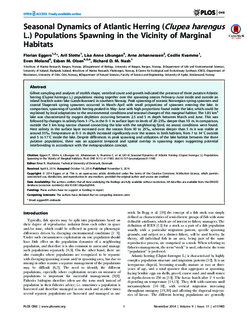| dc.contributor.author | Eggers, Florian | |
| dc.contributor.author | Slotte, Aril | |
| dc.contributor.author | Libungan, Lisa Anne | |
| dc.contributor.author | Johannessen, Arne | |
| dc.contributor.author | Kvamme, Cecilie | |
| dc.contributor.author | Moland, Even | |
| dc.contributor.author | Olsen, Esben Moland | |
| dc.contributor.author | Nash, Richard D.M. | |
| dc.date.accessioned | 2015-01-29T15:42:56Z | |
| dc.date.available | 2015-01-29T15:42:56Z | |
| dc.date.issued | 2014-11-05 | |
| dc.identifier.citation | Eggers F, Slotte A, Libungan LA, Johannessen A, Kvamme C, et al. (2014) Seasonal Dynamics of Atlantic Herring (Clupea harengus L.) Populations Spawning in the Vicinity of Marginal Habitats. PLoS ONE 9(11): e111985. doi:10.1371/journal.pone.0111985 | nb_NO |
| dc.identifier.issn | 1932-6203 | |
| dc.identifier.uri | http://hdl.handle.net/11250/275070 | |
| dc.description.abstract | Gillnet sampling and analyses of otolith shape, vertebral count and growth indicated the presence of three putative Atlantic herring (Clupea harengus L.) populations mixing together over the spawning season February–June inside and outside an inland brackish water lake (Landvikvannet) in southern Norway. Peak spawning of oceanic Norwegian spring spawners and coastal Skagerrak spring spawners occurred in March–April with small proportions of spawners entering the lake. In comparison, spawning of Landvik herring peaked in May–June with high proportions found inside the lake, which could be explained by local adaptations to the environmental conditions and seasonal changes of this marginal habitat. The 1.85 km2 lake was characterized by oxygen depletion occurring between 2.5 and 5 m depth between March and June. This was followed by changes in salinity from 1–7‰ in the 0–1 m surface layer to levels of 20–25‰ deeper than 10 m. In comparison, outside the 3 km long narrow channel connecting the lake with the neighboring fjord, no anoxic conditions were found. Here salinity in the surface layer increased over the season from 10 to 25‰, whereas deeper than 5 m it was stable at around 35‰. Temperature at 0–5 m depth increased significantly over the season in both habitats, from 7 to 14°C outside and 5 to 17°C inside the lake. Despite differences in peak spawning and utilization of the lake habitat between the three putative populations, there was an apparent temporal and spatial overlap in spawning stages suggesting potential interbreeding in accordance with the metapopulation concept. | nb_NO |
| dc.language.iso | eng | nb_NO |
| dc.publisher | Public Library of Science | nb_NO |
| dc.rights | Navngivelse 3.0 Norge | * |
| dc.rights.uri | http://creativecommons.org/licenses/by/3.0/no/ | * |
| dc.title | Seasonal Dynamics of Atlantic Herring (Clupea harengus L.) Populations Spawning in the Vicinity of Marginal Habitats | nb_NO |
| dc.type | Journal article | nb_NO |
| dc.type | Peer reviewed | nb_NO |
| dc.subject.nsi | VDP::Agriculture and fishery disciplines: 900::Fisheries science: 920::Resource biology: 921 | nb_NO |
| dc.source.pagenumber | 13 p. | nb_NO |
| dc.source.volume | 9 | nb_NO |
| dc.source.journal | PLoS ONE | nb_NO |
| dc.source.issue | 11 | nb_NO |
| dc.identifier.doi | 10.1371/journal.pone.0111985 | |

